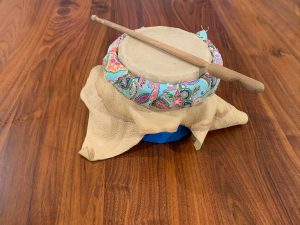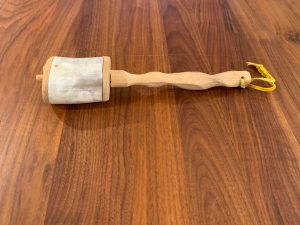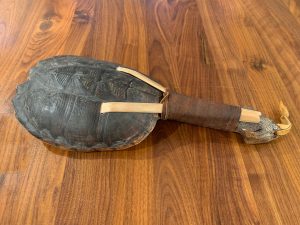The Onondaga ceremonies give thanks and reflect the surrounding living world. At Onondaga we have ceremonial songs and social songs. Ceremonial songs are only performed in the longhouse and are not for public viewing. While social songs can be performed anywhere we want to be social and have lots of fun.
Dances and songs are performed in a counter-clockwise direction. The bean plant, the mother earth, the moon, and the stars; all move in this life providing direction and so do we when we dance. We consider singing and dancing as another way to give thanks. The more spirited you sing and dance, the more you show the Creator how thankful you are. In this fashion, the songs that were given to us so long ago are still being carried on today.
Gana’jyó•wih – Drum
 Our songs are sung using drums and rattles. Drums are usually made of cedar trees with deer hide stretched over the top. A small portion of a cedar log is hollowed out and waterproofed. Water is then poured into the bottom of the drum and the deer hide is stretched over the top of the cedar. The wet leather is then stretched and tightened before a rim is added to hold the stretched leather into place. The singer tests the drum and listens for a nice high tone. Adjustments are made until the drum is ready. Songs are usually sung with one drum.
Our songs are sung using drums and rattles. Drums are usually made of cedar trees with deer hide stretched over the top. A small portion of a cedar log is hollowed out and waterproofed. Water is then poured into the bottom of the drum and the deer hide is stretched over the top of the cedar. The wet leather is then stretched and tightened before a rim is added to hold the stretched leather into place. The singer tests the drum and listens for a nice high tone. Adjustments are made until the drum is ready. Songs are usually sung with one drum.
Gasdawéñ’shä•’ – Rattle
The Onondaga and Haudenosaunee generally use two types of rattles. The horn rattle usually accompanies the water drum.
Horn Rattle
 The horn rattle is an animal horn, usually a cow, which also has been dried and hollowed out. A circular wooden top and bottom is carved to fit the horn. Then a wooden handle is carved and fitted to go through the top and bottom of the rattles. In the final step, seeds are placed inside to make a rattle sound. These rattles are used by the singers who accompany the lead singer who plays the water drum.
The horn rattle is an animal horn, usually a cow, which also has been dried and hollowed out. A circular wooden top and bottom is carved to fit the horn. Then a wooden handle is carved and fitted to go through the top and bottom of the rattles. In the final step, seeds are placed inside to make a rattle sound. These rattles are used by the singers who accompany the lead singer who plays the water drum.
Turtle Rattle
 The second type of rattle is the turtle rattle. This rattle is very sacred to the Haudenosaunee and is only used in a few select ceremonies. The snapping turtle are caught for the sole purpose for making this special rattle. Once the turtle has been sacrificed and hung to dry, skilled craftsmen carve wooden braces that are braced inside the shell along with seeds before the rattle is sewn back together. Individuals who own such rattles take great care in preserving their rattles as a turtle’s life was sacrificed for the ceremonies it now participates in.
The second type of rattle is the turtle rattle. This rattle is very sacred to the Haudenosaunee and is only used in a few select ceremonies. The snapping turtle are caught for the sole purpose for making this special rattle. Once the turtle has been sacrificed and hung to dry, skilled craftsmen carve wooden braces that are braced inside the shell along with seeds before the rattle is sewn back together. Individuals who own such rattles take great care in preserving their rattles as a turtle’s life was sacrificed for the ceremonies it now participates in.
Below is a sample of some Haudenosaunee social dances:
